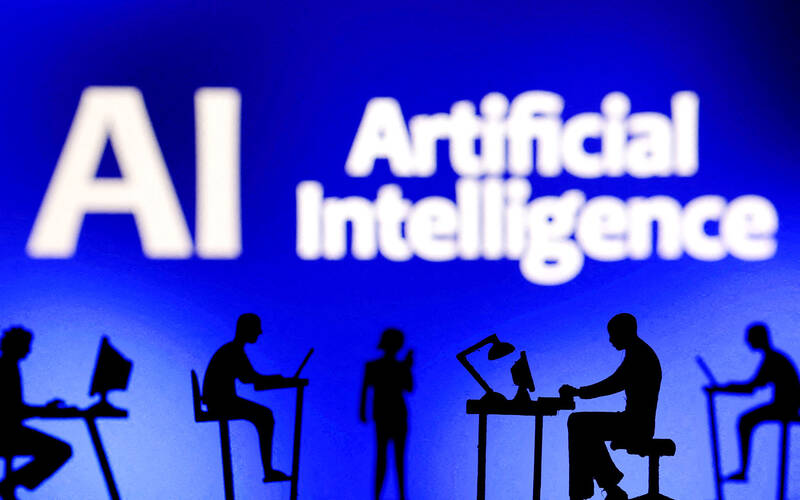At Computex 2025, Nvidia CEO Jensen Huang (黃仁勳) urged the government to subsidize AI.
“All schools in Taiwan must integrate AI into their curricula,” he declared.
A few months earlier, he said, “If I were a student today, I’d immediately start using tools like ChatGPT, Gemini Pro and Grok to learn, write and accelerate my thinking.”

Photo: REUTERS
Huang sees the AI-bullet train leaving the station. And as one of its drivers, he’s worried about youth not getting on board — bad for their careers, and bad for his workforce.
As a semiconductor supply-chain powerhouse and AI hub wannabe, Taiwan is seeing explosive growth in AI-related jobs. In early 2024, Taiwan’s 104 Job Bank (104人力銀行) said a keyword search for “AI” showed 24,000 AI-related openings—with many relating to ability to use ChatGPT. More recently, Minister of Economic Affairs J.W. Kuo (郭智輝) said his ministry is committed to developing a talent pool of over 200,000 AI professionals over the next few years."
In response, Taiwan has scrambled. The Taiwan AI College Alliance aims to train 10,000 professionals in three years. AI electives are rolling out in 23 high schools, supported by online platforms accessible even in rural areas.

Photo courtesy of the Ministry of Education
But we’ll need more than engineers: marketers to test ideas, journalists to verify facts, nurses to enhance care. Every job will have an AI layer.
LinkedIn’s 2025 report predicts that by 2030, 70 percent of the skills used in most jobs will change, with AI as the key driver. Education must prepare people for that too.
TEACHERS AND STUDENTS
The Ministry of Education (MoE) has responded with Generative AI learning partners and AI competitions for younger students. It’s training teachers and released Digital Teaching Guidelines 3.0 to help schools integrate AI while managing risks. These initiatives are the equivalent of preparing electric batteries for the AI bullet train.
On this front, Taiwan is holding its own. Singapore mandates AI and ethics modules. South Korea plans AI classes in all high schools this year and is retraining 5,000 teachers. Finland emphasizes using AI to promote creativity, transparency and citizenship.
But the clock is ticking. The threat isn’t just about cultivating AI talent. It’s about reskilling the broader workforce before it’s left behind. For many translators, copywriters and media designers, the train has already departed. Generative AI has replaced or sidelined many of them — relegating them to the dusty steam engine trains of yesterday.
Next in line? Entry-level jobs.
A global LinkedIn survey of 3,000 senior executives found that 63 percent expect AI to absorb many of the repetitive tasks now done by entry-level staff. IBM’s 2025 CEO study says 61 percent of CEOs are deploying AI agents. Microsoft reports 82 percent of companies plan to add them as “digital team members” within 12–18 months.
Taiwanese companies? The Microsoft report says 88 percent of Taiwanese CEOs view this year as critical for rethinking strategy. A PwC survey found that while only 8–10 percent of local firms have mature AI use cases, over 90 percent are actively exploring them.
DISRUPTIONS
Of course, we should be wary of these reports — they come from companies with vested interests in selling AI. But even Dario Amodei, CEO of Anthropic (creators of Claude, the “ethical” rival to ChatGPT), warns of disruption.
“We have a duty to be honest about what is coming,” he says.
He estimates that AI could eliminate 50 percent of entry-level office jobs and raise unemployment by 10–20 percent.
It’s not looking good for graduates. In the US, youth unemployment is up 30 percent since late 2022. In Taiwan, 11.33 percent of 20–24-year-olds are out of work — more than triple the national average.
The “career ladder’s bottom rung” is “breaking,” according to Aneesh Raman, chief economic opportunity officer at LinkedIn. The AI-bullet train has limited seating. Sadly, the steam train has plenty.
So, what does this mean for education?
KEY SKILLS
That’s the trillion-dollar question. AI tech is moving at bullet-train speed and we can’t predict the future — not even three years ahead. But tech leaders of trillion-dollar companies are pointing to key skills.
Microsoft AI CEO Mustafa Suleyman says adaptability, self-learning and collaboration are essential. Peter Thiel says “math” people have more to worry about than “word” people, since soft skills are harder to automate. Jensen Huang emphasizes mastering AI tools and prompt technique.
“You can’t just randomly ask [AI] questions… it requires some expertise and artistry.”
That means students need more than basic content knowledge in Chinese, civics, math, science and English. They need transferable skills and AI literacy to amplify them.
But Taiwan’s 2019 “108 Curriculum Guidelines” already highlight core competencies like creativity, communication, problem-solving and democratic values — also known as 21st Century Skills. These also align perfectly with an AI-powered, project-based, interdisciplinary model. Imagine students using ChatGPT to design bilingual presentations, analyze data, simulate debates or create podcasts. This, presumably, is what Huang had in mind when he spoke about using AI to “accelerate thinking.”
But it’s not happening. And it won’t — despite all the AI initiatives, training and subsidies.
STUCK IN THE PAST
Why? Because the exam system dominates everything. The Junior (BCT) and Senior High (GSAT) leaving exams are the coal fueling the steam engine — even though its fire died long ago. The engine is stuck in the industrial age.
Even the authors of the 2019 Guidelines knew this. Their vision was clear: move from content cramming to holistic, flexible, competency-based learning. They wanted portfolios, school-designed curricula and assessments that measure more than memorization. They even added competency questions to the big exams to reflect this.
Yet classrooms remain frozen. Students still cram and regurgitate. Teachers, bound by test prep and parental expectations, have no time or space for experimental activities — let alone meaningful AI integration.
Yes, more teachers are using AI to prep their lessons. But few use it in class. Da-tong Senior High English teacher Tracy Chen puts it plainly: “Time constraints and test prep pressure.” She adds, “We still don’t have a clear roadmap for what AI literacy should look like at each level, or where it fits in the curriculum.”
No surprise. The emergence of generative AI caught everyone off guard. Not even tech companies — let alone education ministries — have a clear roadmap. But even if they did, many Taiwan educators would resist major changes. So would cram schools and publishers who benefit from the current examination system. And the education ministry isn’t exactly charging ahead either. Minister of Education Cheng Young-yiu (鄭英耀) last year said, “We are not reforming the guidelines for the sake of reforming.”
That’s ironic, considering the 2019 Guidelines explicitly call for reform. But talk is cheap. Real transformation demands courage, vision and action. And so far, the education ministry seems unwilling — or unable — to retire the steam engine and build the infrastructure needed for an AI-powered bullet train.
But without assessment reform, nothing else matters. No curriculum — AI or otherwise — will change how schools teach if the BCT and GSAT continue to dominate.
GOOD NEWS
The good news? We don’t need to start from scratch. The 2019 Guidelines already provide a foundation to rethink what students learn, how teachers teach, and how we assess both. We just need to truly reform it — with AI in mind. That means prioritizing projects, student portfolios, personalized learning, and collaboration grounded in ethics and 21st Century skills. And de-prioritizing high stakes exams.
There has never been a better time — or better reason — to retire the examination steam engine. Only when students are taught to use AI as a real partner in daily learning will they develop the skills to thrive in the impending AI-driven workplace.
Until then, we’ll keep trying to arrive at Taiwan’s future with an engine stuck in the station. And the industry AI bullet train? It’ll keep speeding away, leaving more graduates behind.

The Taipei Times last week reported that the rising share of seniors in the population is reshaping the nation’s housing markets. According to data from the Ministry of the Interior, about 850,000 residences were occupied by elderly people in the first quarter, including 655,000 that housed only one resident. H&B Realty chief researcher Jessica Hsu (徐佳馨), quoted in the article, said that there is rising demand for elderly-friendly housing, including units with elevators, barrier-free layouts and proximity to healthcare services. Hsu and others cited in the article highlighted the changing family residential dynamics, as children no longer live with parents,

It is jarring how differently Taiwan’s politics is portrayed in the international press compared to the local Chinese-language press. Viewed from abroad, Taiwan is seen as a geopolitical hotspot, or “The Most Dangerous Place on Earth,” as the Economist once blazoned across their cover. Meanwhile, tasked with facing down those existential threats, Taiwan’s leaders are dying their hair pink. These include former president Tsai Ing-wen (蔡英文), Vice President Hsiao Bi-khim (蕭美琴) and Kaohsiung Mayor Chen Chi-mai (陳其邁), among others. They are demonstrating what big fans they are of South Korean K-pop sensations Blackpink ahead of their concerts this weekend in Kaohsiung.

Taiwan is one of the world’s greatest per-capita consumers of seafood. Whereas the average human is thought to eat around 20kg of seafood per year, each Taiwanese gets through 27kg to 35kg of ocean delicacies annually, depending on which source you find most credible. Given the ubiquity of dishes like oyster omelet (蚵仔煎) and milkfish soup (虱目魚湯), the higher estimate may well be correct. By global standards, let alone local consumption patterns, I’m not much of a seafood fan. It’s not just a matter of taste, although that’s part of it. What I’ve read about the environmental impact of the

Oct 20 to Oct 26 After a day of fighting, the Japanese Army’s Second Division was resting when a curious delegation of two Scotsmen and 19 Taiwanese approached their camp. It was Oct. 20, 1895, and the troops had reached Taiye Village (太爺庄) in today’s Hunei District (湖內), Kaohsiung, just 10km away from their final target of Tainan. Led by Presbyterian missionaries Thomas Barclay and Duncan Ferguson, the group informed the Japanese that resistance leader Liu Yung-fu (劉永福) had fled to China the previous night, leaving his Black Flag Army fighters behind and the city in chaos. On behalf of the